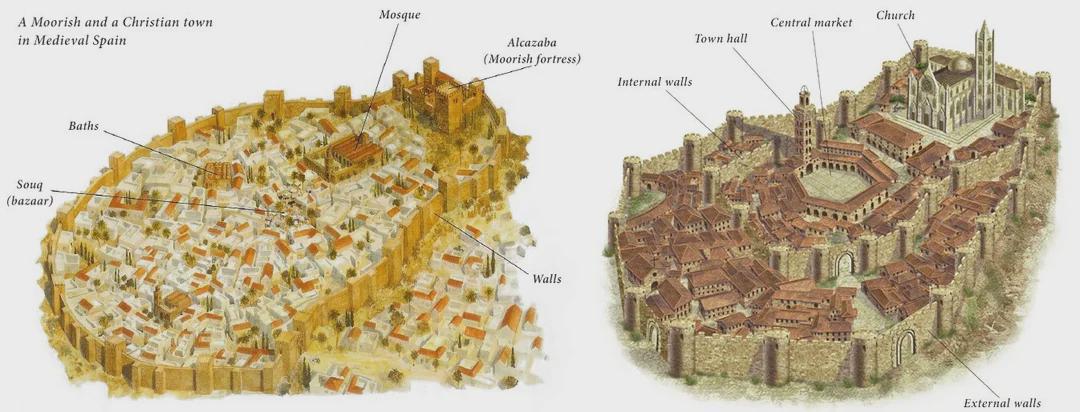Moorish and Christian Towns in Medieval Spain Map


Marcus Rodriguez
Historical Geography Expert
Marcus Rodriguez specializes in historical cartography and geographic data analysis. With a background in both history and geography, he brings unique...
Geographic Analysis
What This Map Shows
The map titled "A Moorish and a Christian Town in Medieval Spain" provides a visual representation of the geographic and cultural landscape during a pivotal period in Spanish history. This visualization highlights the coexistence and conflicts between two dominant religious and cultural groups — the Muslims, known as Moors, and the Christians — during the medieval era. The map not only marks significant towns, cities, and fortifications but also illustrates the territorial changes that occurred as a result of the Reconquista, the centuries-long campaign by Christian kingdoms to reclaim Iberian territory from Muslim rule.
Deep Dive into the Historical Context
What’s fascinating about this period is the intricate tapestry of cultural exchange that existed in Spain. Between the 8th and 15th centuries, the Iberian Peninsula became a melting pot of cultures, where Moorish and Christian influences intermingled. The Moors, who arrived in 711 AD, brought with them advanced knowledge in various fields such as mathematics, astronomy, medicine, and architecture. Cities like Cordoba and Granada flourished under Moorish rule, showcasing stunning architecture exemplified by the Alhambra and the Great Mosque of Cordoba.
On the other hand, Christian kingdoms such as Castile, Aragon, and Leon were steadily gaining ground. The Reconquista began in earnest in the 11th century, marked by significant battles such as the Battle of Las Navas de Tolosa in 1212, which was a turning point in favor of the Christians. This map effectively captures the shifting boundaries and signifies where conflicts and alliances shaped the landscape.
Interestingly, the interactions between these two cultures weren't solely adversarial. They often engaged in trade and shared knowledge, leading to advancements in various domains. For instance, the introduction of new agricultural techniques and crops such as rice and citrus fruits had lasting impacts on Spanish cuisine. The coexistence led to a unique architectural style, known as Mudéjar, which merged Gothic and Islamic styles, evident in numerous structures still standing today.
Statistically, by the time of the fall of Granada in 1492, the last Muslim stronghold in Spain, the Moors had significantly influenced the social and cultural fabric of the region. It's estimated that nearly 700,000 Muslims were living in Spain at that time, many of whom converted to Christianity following the Reconquista but maintained elements of their cultural identity.
Regional Analysis
Examining the map more closely, we can see distinct regions where Moorish and Christian towns were located. In the south, cities like Seville and Granada were under Moorish control, marked by intricate designs and vibrant marketplaces. These cities were not merely centers of political power but also hubs of learning and culture. The architectural remnants speak volumes about their historical significance.
Conversely, in the north, towns like Santiago de Compostela and Toledo were strongholds of Christian kingdoms. Toledo, in particular, is noteworthy for its role as a religious and cultural center where Jewish, Christian, and Muslim scholars collaborated. The map highlights this diversity, showcasing the layered history of these towns that continue to attract tourists and historians alike.
Another point of interest is the border areas, where conflict was rampant. The shifting boundaries indicate how territories were contested and reclaimed, leading to a dynamic landscape. For example, the region around Valencia saw a significant back-and-forth between the two cultures, resulting in a rich blend of architectural styles and agricultural practices. The map serves as a reminder of how these conflicts were not just military in nature but also deeply rooted in cultural exchanges.
Significance and Impact
Understanding the historical context of Moorish and Christian towns in Medieval Spain is crucial for several reasons. First, it allows us to comprehend how culture and conflict can coexist and how they shape society. The legacy of this period is still visible today in Spain’s diverse architecture, language, and traditions.
Moreover, in a modern context, this map can inform discussions about cultural identity and heritage. As we navigate an increasingly globalized world, the Spanish experience offers valuable lessons in coexistence and collaboration across cultures. The historical interplay between the Moors and Christians serves as a reminder that cultural exchange can lead to significant advancements, even amidst conflict.
As we look to the future, it’s essential to recognize the importance of preserving such historical narratives. Current trends show a renewed interest in understanding multicultural histories, which can foster respect and appreciation for diversity. The historical interactions between these two groups continue to resonate, reminding us of the complexities of cultural identity and the forces that shape our world today.
Visualization Details
- Published
- October 10, 2025
- Views
- 4
Comments
Loading comments...